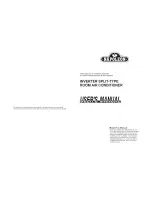
3
Selecting installation place
Read completely, then follow step by step.
Indoor unit
Do not expose the indoor unit to heat or steam.
Select a place where there are no obstacles
in front or around the unit.
Make sure that condensation drainage can
be conveniently routed away.
Do not install near a doorway.
Ensure that the space on the left and right
of the unit is more than 5 inches (12cm).
Use a stud finder to locate studs to prevent unnecessary damage to the wall.
The indoor unit should be installed on the wall at a height of 7 feet (2.0 m) or more from the floor.
The indoor unit should be installed allowing a minimum clearance of 6 inches (15cm) from the ceiling.
Any variations in pipe length will/may require adjustment to refrigerant charge.
There should not be any direct sunlight. Otherwise, the sun will fade the plastic cabinet and
affect its appearance. If unavoidable, sunlight prevention should be taken into consideration.
Outdoor unit
If an awning is built over the outdoor unit to
prevent direct sunlight or rain exposure,
make sure that heat radiation from the
condenser is not restricted.
Ensure that the clearance around the back
of the unit is more than 12 inches (30cm) and left side is
more than 12 inches (30cm). The front of the unit should
have more than 7 feet (2m) of clearance and the
connection side (right side) should have more
than 24 inches (60cm) of clearance.
Do not place animals and plants in the path of the air inlet or outlet.
Take the air conditioner weight into account and select a place where noise and vibration
will not be an issue.
Select a place so that the warm air and noise from the air conditioner do not disturb neighbors.
If the outdoor unit is installed on a roof structure, be sure to level the unit.
Ensure the roof structure and anchoring method are adequate for the unit location.
Consult local codes regarding rooftop mounting.
If the outdoor unit is installed on roof structures or external walls, this may result in
excessive noise and vibration, and may also be classed as a non serviceable installation.
Rooftop installation:
INSTALLATION INSTRUCTIONS
More than 11.9in.( 30cm)
More than 23.7in.( 60cm)
More than 11.9in. (30cm)
More than 6.57ft( 200cm)
Fig.2
More than 6.57ft( 2.0m)
More than 6in.(15cm)
More than 4.73in.(12cm)
More than 4.73in.( 12cm)
Fig.1
1. Wall-mounted type





































